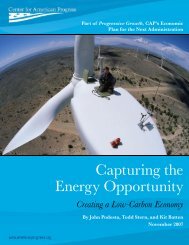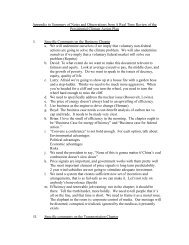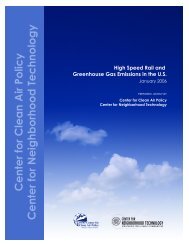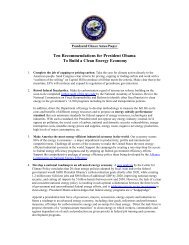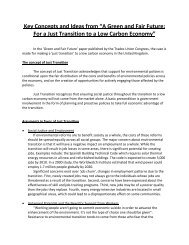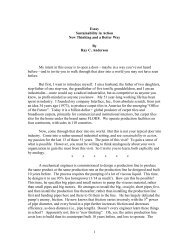PCAP - Presidential Climate Action Project
PCAP - Presidential Climate Action Project
PCAP - Presidential Climate Action Project
- No tags were found...
Create successful ePaper yourself
Turn your PDF publications into a flip-book with our unique Google optimized e-Paper software.
of climate change in California are compelling and extraordinary comparedto the effects in the rest of the country. 213This is a final action by the Agency. 42 U.S.C. § 7607 contemplates review of finaladministrative actions. Review of a final action pursuant to §7543 must be taken in federalcircuit court. Section 7607 also contemplates a petition for reconsideration by the Administrator;however, there is no specific provision in the Code of Federal Regulations or pollutionprevention statutes providing for reconsideration of a waiver denial under §7543.Authority over the EPA. The EPA is neither an executive department nor an independentagency. In terms of the President’s authority over agencies, generally, the President’s authorityover the EPA would be much the same as an executive department. 214 In terms of this specificproposal, there are indicators that the President’s authority is more limited. The CAA delegatesresponsibility for implementation of the CAA directly to the EPA. Further, section 7543(b)explicitly states that it is the Administrator of the EPA who shall make the determinationsnecessary for denying the waiver (see Statutes section above). Thus, the President can order theEPA to make a specific determination but it is not enforceable 215 and it falls within the categoryof overreaching by the President. However, the President can re-establish federal policy in thisregard.The Agency’s determination is, in part, based on the view that a national problem such as globalwarming should have a national approach (i.e., the same standard in every state). The Presidenthas substantial authority in planning federal energy and climate change policy as discussed inChapter II. The President could issue an executive order establishing a climate change policy thatwould encourage actions such as waivers for states that want to be more aggressive in theirapproach. Although the Agency has already taken final action on the waiver, such an executiveorder could impact any future reconsideration of the issue based on the outcome of the federalcase, for example. On the other hand, the agency’s decision is largely based on Agencyinterpretation of the statutory provision. Thus, if the federal court agrees with the agencyinterpretation, the outcome of the federal case may conclude this matter. A presidential policyshift will not provide the authority necessary to grant this particular waiver under section7453(b).Conclusion. This conclusion is subordinate to the outcome of the federal case. Any actiontaken by the President should be consistent with a federal ruling on the matter. First, the EPAAdministrator has taken final action on the waiver. There is a statutory provision that delegatesthis determination specifically to the Administrator. The President cannot substitute hisdetermination for that of the Administrator. However, the Administrator’s determination wasbased, in part, on the Agency’s view of national policy. The President can make clear, or reestablishthrough an executive directive, the policy of the U.S. in this regard. This could havebearing on the outcome of the federal case if it has not been decided when the next213 73 CFR 12,156.214 Boundaries Report, Chapter VI(1)(c).215 The President’s only recourse would be to discharge the Administrator and any future Administrator who did notgrant the waiver.CEES 51 | P age




